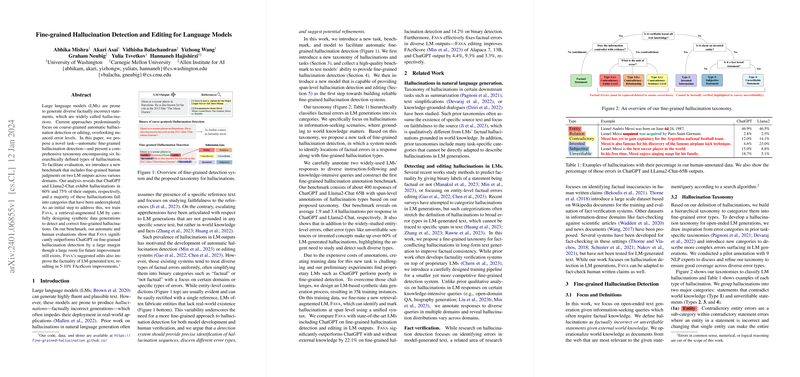Introduction
LLMs (LMs) have become quite adept at generating fluent and coherent language. Despite the apparent progress, these models exhibit a critical drawback: they often produce text containing factually incorrect information, known as "hallucinations." The research community has addressed the phenomenon of hallucinations by developing detection and correction mechanisms. However, these tend to be coarse-grained, simplifying the problem into binary categories of either factual or non-factual. Recognizing the limitations of current systems, researchers recently stepped forward with an innovative approach to tackle the issue of hallucinations with greater precision.
Taxonomy of Hallucinations
For a nuanced understanding of hallucinations, a novel taxonomy has been proposed, which categorizes factual errors in LM generations into six distinct types. This taxonomy is particularly of interest in scenarios where responses must be grounded in world knowledge. The six detailed categories include commonly recognized entity-level errors but also highlight underexplored areas like unverifiable statements and invented concepts. The proposed taxonomy includes contradictory entity and relation errors, entire statements that directly contradict known facts, fabrications about non-existent entities or concepts, personal biases disguised as facts, and statements that cannot be verified against world knowledge.
Fine-grained Hallucination Detection
The researchers designed a task to accompany their taxonomy—a task that centers on detecting the specific hallucination type for a given factual error in a LLM's response. To accomplish this, a fine-grained hallucination detection benchmark was constructed, featuring human-annotated responses from widely-used models across different domains. Analyses reveal that both ChatGPT and Llama2-Chat exhibit high rates of hallucinations, emphasizing the urgent need for sophisticated detection methods.
The Fava Model
To address the challenge, the researchers introduced Fava, a retrieval-augmented LLM. Unlike its predecessors, Fava is trained on synthetic data specifically designed to reflect the nuanced taxonomy. It not only detects hallucinations but also suggests corrections at a fine-grained level. Results have shown Fava to be significantly more effective at detecting and editing hallucinations compared to existing systems like ChatGPT. Despite this leap in performance, the researchers acknowledge there is still considerable room for improvement in this area of LLM development.
Fava represents a strategic advance in the endeavor to enhance the reliability and factuality of LLM outputs, marking a milestone in the ongoing development of AI-driven natural language processing. The supporting materials, including code, data, and a demonstration, have been made available for interested parties.
Discoveries in AI continue to unfold, and with them, the tools and methodologies to refine these powerful systems evolve as well. The emergence of fine-grained hallucination detection not only enhances current applications but also opens new avenues for future AI deployments in fields where factual accuracy is paramount.
